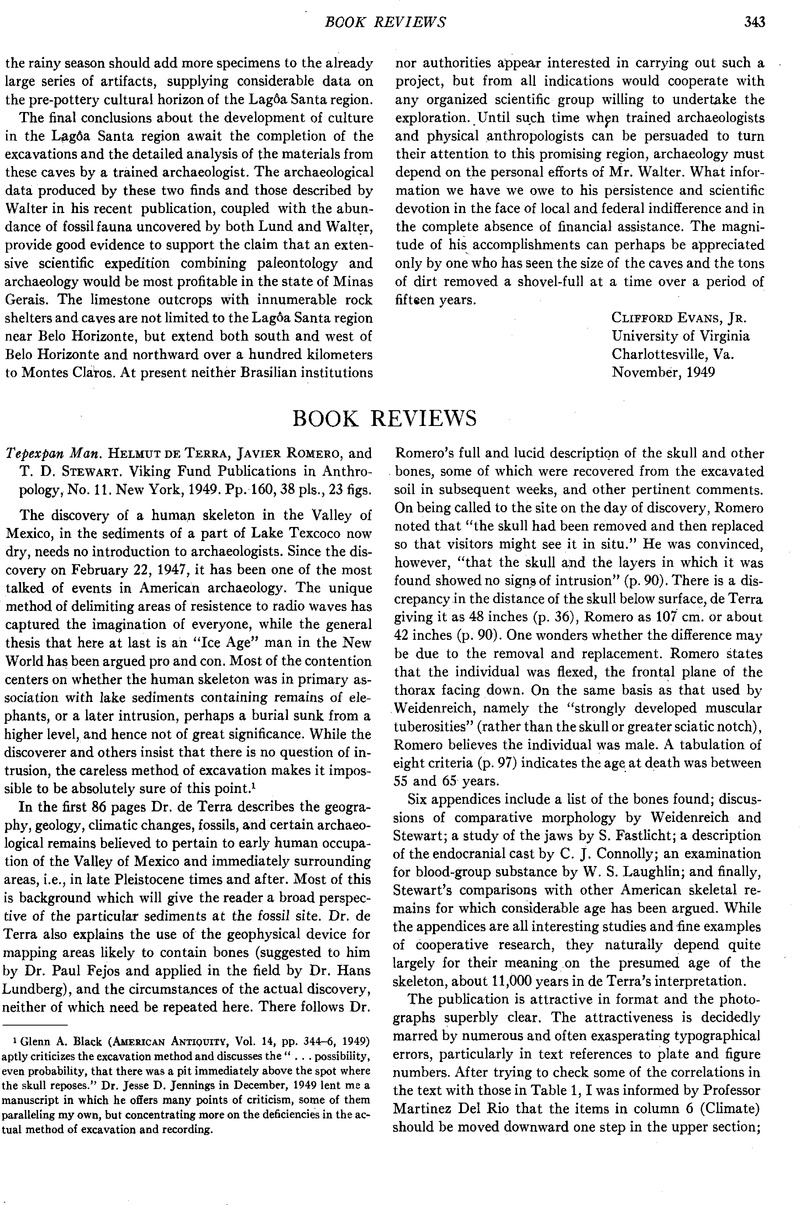Published online by Cambridge University Press: 25 January 2017

1 Glenn A. Black (American Antiquity, Vol. 14, pp. 344–6, 1949) aptly criticizes the excavation method and discusses the “... possibility, even probability, that there was a pit immediately above the spot where the skull reposes.” Dr. Jesse D. Jennings in December, 1949 lent me a manuscript in which he offers many points of criticism, some of them paralleling my own, but concentrating more on the deficiencies in the actual method of excavation and recording.
2 A. R. V. Arellano, “El elefante fosil de Tepexpam y el hombre primi-tive,” Revisla Mexicana de Estudios Antropológicos, Tomo VIII, pp. 89–94, Mexico, D. F., 1946.
3 A serious confusion is plainly evident in Plate 3. Panel A has five numbered layers, panel B six, yet the caption says that the layers of B are the same as A, and Stratum 6 is El Risco. If this is so, Stratum 5 is nameless. It may be suspected that Stratum 6 is Becerra (with the mammoth fossil) and that 5 is El Risco in both panels.
4 Ernst Antevs, “The Great Basin, with Emphasis on Glacial and Postglacial Times,” Bulletin, University of Utah, Vol. 38, No. 20, pp. 168–91, Salt Lake City, 1948.
5 For a summary of various theories and a critical review, see H. C. Willett, “Long-Period Fluctuations of the General Circulation of the Atmosphere,” Journal of Meteorology, Vol. 6, pp. 34–50, Lancaster, Pa., 1949.
6 Glen L. Evans, geologist and Assistant Director of the Texas Memorial Museum, Austin, has supplied me with a brief statement of the caliche problem posed here: “The term ‘caliche’ is commonly applied to impure calcareous rocks in which the calcium carbonate has been secondarily introduced or concentrated. Such caliches characteristically develop at surface or shallow subsurface horizons under arid climatic conditions. Caliche may form as a surficial crust due to evaporation of ascending lime-charged waters, or it may develop at the base of the leached zone of a soil profile, or may form in any of several other ways. Consequently when a caliche zone is used as a stratigraphic marker, an interpretation of its particular origin becomes important. If Caliche III is the result of leaching of an overlying soil, it may be of essentially the same age as the materials immediately above. Whereas, if the caliche formed as a surface encrustation, it may be considerably older than the overlying strata.”
7 A letter from Professor Kirk Bryan states that the caliche and underlying El Risco material were both eroded by the Zacatenco Lake, and directly over the skeleton there was only a paper-thin caliche. Could the thinness be due to the caliche only having started to form again after the Zacatenco Lake had receded beyond this point?
8 It probably falls within the range of “Nebo Hill points,” illustrated by J. M. Shippee in American Antiquity, Vol. 14, pp. 29–32, Pl. II. Jack T. Hughes, excavating for the River Basins Survey in the Angostura Reservoir basin, South Dakota, in 1948 and 1949, found points of similar shape which he calls “Long points.” Further study will probably reveal that this form is quite widespread.